
The most discussed SEGA console, which however enjoyed great success in Japan and is for many a great unknown, although it has a long list of great games.
- Texts and those heavy hours of compilation: Gustavo Benéitez
- Design, gravel and "logistic" support various: David Borrachero Goossens
On the occasion of the 25th anniversary of its launch in Japan, we recover this report that reviews the life and death of a console that has always maintained a great attraction based on a library of Japanese jewels that did not make the leap to the West.
The next generation of consoles is about to arrive. It will be the first time that SEGA is not included among the companies involved in the new struggle of an emerging market, capable of surpassing the film industry in business volume, to give a clear example.
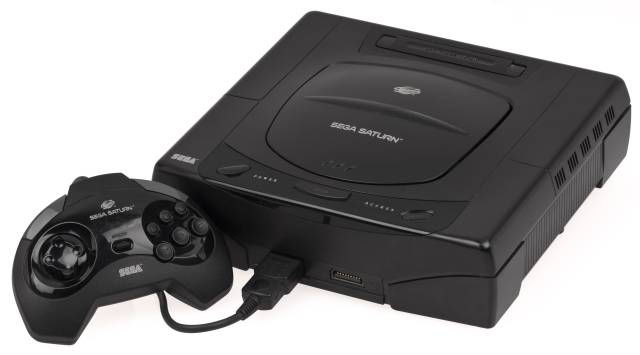 Sega Saturn
Sega Saturn
"Generation" is a term that we apply since the age of 16 bits and that since then the giants of electronic entertainment have been presenting their hardware in more or less simultaneous terms. The struggle between the big manufacturers marks the beginning of a new stage, and in the case of the consoles it also opens a path with no possible turning back, so a calculation error can be fatal.
Sega Saturn is the console (not added or complement) more controversial of how many SEGA has launched in its long history. His failure meant a blow to the coffers of the Japanese company, to the point that his successor could never compete on equal terms with his competitors, and SEGA finally had to give up and withdraw from a market, the hardware, through which With such ingenuity and quality he had managed to match the hitherto undisputed queen: Nintendo. The delicate financial situation of the European and American subsidiaries, the continuous friction between Tom Kalinske (president of Sega of America) and the Japanese parent company, with its president Hayao Nakayama at the head, and fundamentally the appearance of Sony in the market led SEGA to a very difficult situation that has triggered today in the "merger" with Sammy Enterprises.
In the following pages we wanted to make a small tribute to the history of the 32-bit SEGA console and we have divided it into different parts to make reading more enjoyable. First a brief review of the design of the console, then a review of the first games, the highlights of the catalog, the last titles of the catalog and the end of its days, and finally some paragraphs dedicated to the most known peripherals for the console and our conclusions Prepared?..
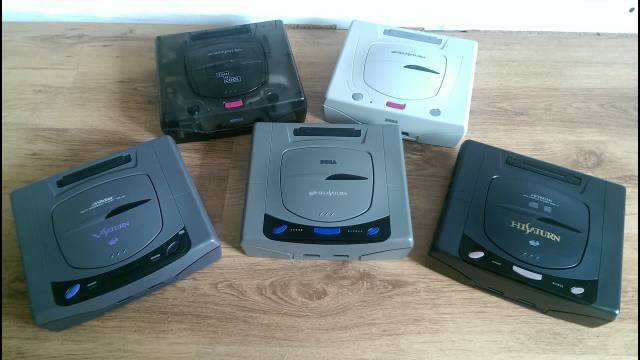
The origins
Legend has it that SEGA had a successor ready for its 16-bit star console, Megadrive, anticipating Nintendo's movements again. However, a year before its launch, when the technicians finalized the software base that accompanies a console (libraries, operating system, etc.) Sony presented to the experts a review of a machine dismissed by Nintendo itself. At the head of his technical team was Ken Kutaragi, an ambitious engineer whose professional experience had always been linked to other fields of electronics. Only a demonstration to the press was enough for the collective hysteria to run in the SEGA headquarters. Its engineers had designed a machine capable of leaving anything seen up to date in two dimensions, surpassing NeoGeo, Super Nintendo and Mega Drive, the largest references in the domestic sector worldwide. But in the 3D chipset they had been somewhat scratchy, and the specifications provided by Sony itself far exceeded what the SEGA console could offer.
From this point on, the story is not clear. What we do know is that the console finally included two twin RISC processors, the SH2, short for Sega Hitachi Step 2, and several mathematical and geometric coprocessors that, like the main processors, could work in parallel and be programmed independently. Apparently, the first version of Saturn had only one processor (even SEGA even published press releases that clearly spoke of a single central processor and a VDP) and the limited time frame available to SEGA engineers (with Hideki Sato as leader) to react prevented changing a complete chipset, so they opted to give each party more power by doubling the processing power, adding a concept already known in SEGA studies: multiprocessing, but that was only used in some of their arcade cards, and curiously on Mega CD (when using their own processor next to Megadrive).
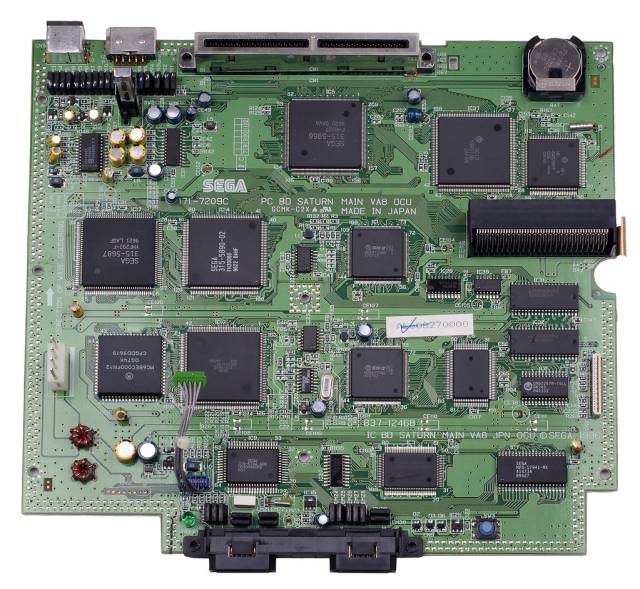 Saturn motherboard
Saturn motherboard
We are talking about the years between 1992 and 1994. At that time it was much cheaper to include two processors than to increase the clock frequency of the set to rival PlayStation. SEGA also continued in the old school line: lots of documents explaining in detail each point of Saturn's hardware, a multitude of ways to push the console to the limit and squeeze each of its chips by assembler. However, the industry was changing at the same time: programming groups grew, investments multiplied, times were reduced and the need to obtain benefits forced the "third parties" to seek a more profitable model, which offered Sony with its PlayStation and its libraries in C; The intricacies of the machine were not reached, but the development time was much shorter.
Much has been said about it, was it a wise decision? Of course not. It was said that PlayStation was clearly superior to its rival, something that is not essentially true. Sega Saturn had a probably superior brute force and more RAM, but its architecture was a real workhorse for developers. All the effects that PlayStation did for hardware had its replica on Saturn, but for software, and with the aggravating fact that they had to be distributed among their coprocessors if they wanted to optimize performance, something really difficult and that certainly not even the first games SEGA could achieve. In an interview with Yu Suzuki himself, he stated that Saturn was a very complicated machine to program and that the dual processor was a stumbling block that only a few programmers worldwide could overcome. From his words, apart from a certain exaggeration, a small criticism can be drawn from the designers of his company, since a commercial product should not be a professional challenge, but a machine at the service of entertainment and creativity.
The philosophy that SEGA engineers used in a way is the same as that used by Kutaragi on their PlayStation 2, of course the technology has advanced, but it is clear that to get the most out of both machines you have to dig deep into your hardware . The difference in results is clear, Saturn was abandoned by developers while PS2 is currently number one in sales. Some blamed the lack of graphic power and not the laziness of programmers, the truth is that there are games with transparencies (one of the most commented effects in comparisons with PSX games), with dynamic light effects, shadows and high polygonal load, such as Burning Rangers. But it is clear that development time is very expensive, and in this industry the human teams are there to make money, not to make demonstrations.
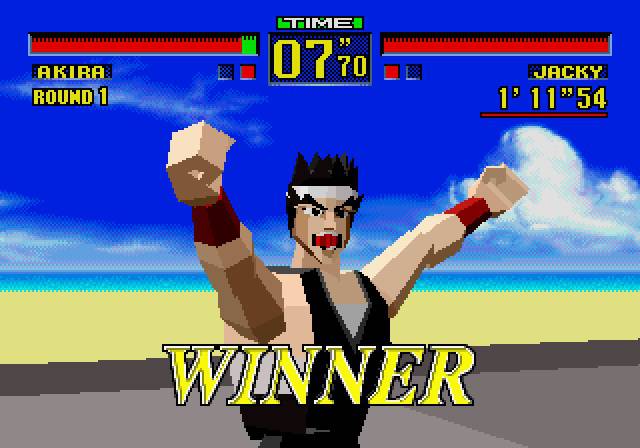
During the first months, Virtua Fighter won the game to Ridge Racer, but soon Namco began adding games to the ever-growing Sony Gray catalog, and SEGA had a very big problem: the software. It is known that when Saturn reached the American market, in Japan Playstation already had a very attractive catalog, and while Sega Saturn survived with the games published under the archifamous palm of AM2. It was the bane of the console, a total disorganization between Sega Japan and Sega of America that made, on the one hand the development kits of the 32X parallel project arrive at the same time or even later than those of Saturn itself, and on the other , that these were not the definitive ones, and as it is already known the learning curve was very abrupt. This made both in America and in Europe, where public disinterest was even greater, Sega unfortunately lost the battle as soon as he began.
An unequal battle
During the first year of life of the console, it was more than evident that only Sega's internal studies were able to do interesting things on the machine. An improved version of Virtua Fighter, Remix, made the one that had published months before AM2 pale. It revealed once again the rush and urgency with which the Japanese company had done things, and the same would happen again with Daytona USA. Although the conversion put on screen the 40 cars of the arcade and reflected its speed, neither the resolution shown nor the enormous graphic failures or the presence of an overwhelming "popping" could satisfy the specialized press, which began to distrust its real possibilities
Shortly after Panzer Dragoon appeared, a graphically superior title to everything seen on any home console to date. Neither Toshinden, nor Tekken, nor the Ridge Racer were as beautiful as riding the dragon's back and controlling the chosen one. It served to change some opinions, but not to revive hardware sales, and the Saturn crisis had no solution. From that moment, the development of the "third parties" opted for the gray of Sony, who had Psygnosis, the aforementioned Namco and Square, among its bastions, which catapulted sales throughout the world with its Final Fantasy. It is even curious how Capcom, one of the few who did not abandon Sega during his hardship, published Resident Evil in the first instance and later Dino Crisis on Playstation, while exploiting RAM memory to the maximum and using additional cartridges to adapt his 2D type arcades Street Fighter and the emerging "cross overs".
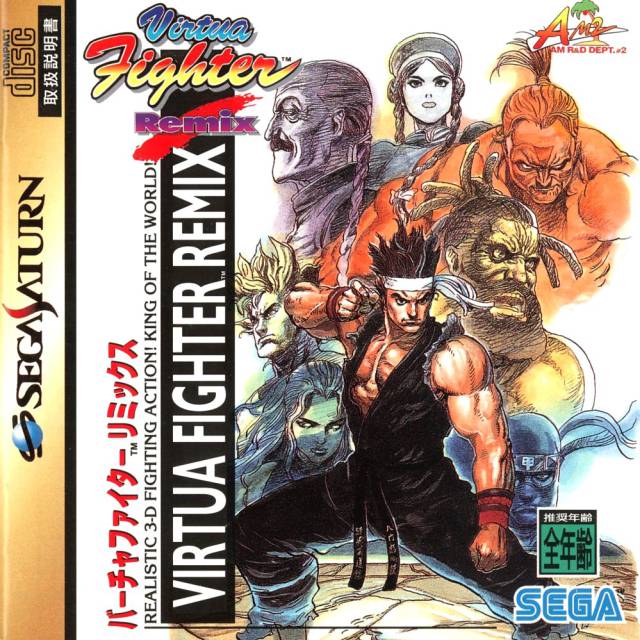 The original Virtua Fighter conversion was so hasty that they had to launch the much improved Remix
The original Virtua Fighter conversion was so hasty that they had to launch the much improved Remix
The launch star title in Japan, country where fighting arcades live with special fondness, and where Tekken does not have as much name as the Yu Suzuki saga and his team in AM2. Much deeper than any other game, with many more movements than Toshinden or Tekken, it presented some improper lacks of a title destined to sell machines and surprise the public. The polygons dancers, who disappeared when the camera rotated and even in the repetitions became famous, and even provoked the mockery in many videoaddicts. However, despite his flaws, he only won the game to Sony and its marketing machinery for months, enduring the pull of Playstation, 3DO and Neo Geo CD together.
A second part was programmed which, from my modest point of view, became the best fighting title for a player of the last generation. Certainly, "Tekken 3" is more spectacular, but "Virtua Fighter" moves in high resolution, and all movements and keys of the original are reproduced in the domestic version. He arrived a little on tiptoe, along with Sega Rally, but it was Saturn's best-selling game in Japan. In the West it was another of the great ignored, but no one doubted the technical capabilities of an almost dead console. Even so, we received "Virtua Fighter Kids", a kind of parody of the same game with big-headed characters, a fashion imposed from Japan that was reflected in other Sony products such as "Wild Arms".
The Virtua Fighter fever made a rumor run: its third installment (VF3) was still going to run on the circuits of a Saturn, and to work the miracle SEGA would have chosen to use the 4MB cartridge. This rumor was never denied, although VF3 finally appeared (converted by Genki) in the next generation. What we have known a posteriori is that Yu Suzuki planned to take out nothing more or less than the very "Shenmue", supported by the same cartridge. The end of ShenMue 2 itself reveals a video of itself in its 32-bit version and the truth is that, saving the obvious distances, it does not detract at all.
Panzer Dragoon, game flag
Programmed by Team Andromeda, it is rumored that its production was one of the most expensive of the moment. It featured the designs of Moebius, an orchestrated soundtrack of taking off his hat, and amazing cinematic sequences for the time. A simple "on rails" shooter, one of those with a preset path and 360 degree sight glass, and with some freedom of movement on the back of a dragon, became the technical reference of his generation. It cleared doubts about Saturn hardware, but evidenced that it was very expensive to get games of similar invoice.
His second part, Zweii, was even better. The story was repeated many years later, new extras and the possibility of choosing the route laid the foundations of what would later be Xbox Panzer Dragon Orta. It is one of the most sought after titles in the PAL market, although fortunately it is not too difficult to find it or too expensive.
The trilogy closes with Azel: Panzer Dragon Saga, a phenomenal role-playing game that, apart from the action of the first two, combines arcade mechanics with the role in turns with a most addictive result. It is a work of art of gameplay design, whoever has finished it knows that it is practically impossible to detach from it until it is finished. Sin maybe short and being too linear, something that could not rival Final Fantasy, but we have all expected the continuation of his universe even if Team Andromeda has dissolved after its production. Eye, this game, in PAL format, can exceed 150 euros in any auction today
In its beginnings, Sega's goal was to create continuations of some popular Mega Drive genres, but with new effects, more scroll planes, color and animation frames. Among them were the platforms, and therefore designed Clockwork and Astal. Both were titles almost out of the machine, one in a pseudo-3D universe and the second fully realized by hand and with the cartoon aesthetics that allowed 32 bits.
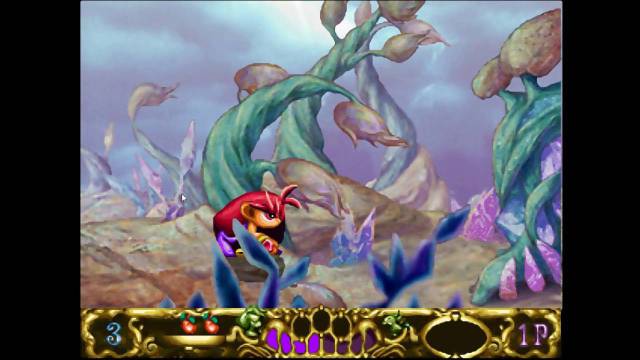 Astal, one of the most beautiful 2D games of its time
Astal, one of the most beautiful 2D games of its time
Once again, Sega was unfortunate in his choice: Clockwork was actually the first half of a game that they decided to separate to sell more, and it ended up being a short and incomplete title, although original and fun; neither this nor its second part enjoyed good sales, and were unfairly ignored by the market. The pseudo-3D would later be reused in many Saturn and PlayStation games
As for Astal, let's say it appeared at the same time as, for example, "Jumping Flash" on PlayStation. Astal is a great game, much better than Sony's JF, but it denotes the trend of both companies competing for a market based on color versus innovation. It was not even brought to the European market, despite its enormous quality (of the time), and came to show that even Sega did not trust his product.
Other platform games arrived in Europe, such as Bug! and Bug too !, entirely in 3D, a good technical invoice and a lot of gameplay and laughs. Obviously, they are filling titles in an irregular catalog that made them notable, there are others much better on PlayStation, for example the Spyro saga, a somewhat more childish theme but they sold much more; or the same Crash Bandicoot, supposed mascot of the machine in its beginnings.
In this genre, the undisputed winner was Nintendo's Super Mario 64. He set the bar very high, when in addition Sega Saturn no longer had good reviews. Sony also did its own by publishing the aforementioned, or Croc, Pandemonium (games that were later converted to Saturn) or the great Tombi and Klonoa. Without a decent Sonic, the console could do nothing to counteract the effect of the above.
Sega Rally, a colossus from the recreational
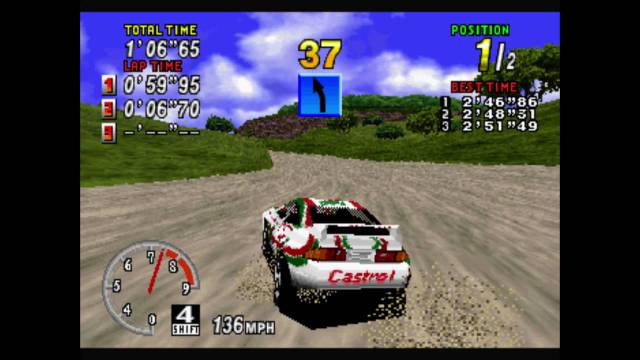
"The conversion" without a doubt. You can compare many things between the titles of Saturn and PlayStation. Indeed, Gran Turismo can technically make any other 32-bit pale, even the V-Rally or Collin McRae saga, but the charm of a recreational never moved as satisfactorily as in this title.
Bearer of the remodeling of the Sega graphic libraries, and the use of the C at the expense of the assembler, was identical to the recreational one (except the resolution and the transparencies) that was part of the Sega legend in salons around the world . He arrived late, but he arrived. The wait was worth it and yet left a bittersweet taste, since at that time almost everything was opted for by Sony's console.
Team Sonic (now Camelot), also known as Sonic Software Planning, took this juicy license giving it a new dimension. Based on the latest installment of Mega Drive, three Role titles emerged that encompassed three different genres: Shining Wisdom, an SNES Zelda-type RPG action, with some grace but very chaotic; Shining The Holy Ark, very similar to the Ishar, Eye of the Beholder or Lands of Lore of PC; and a wonder called Shining Force 3, commercially divided into three chapters that appeared consecutively in Japan.
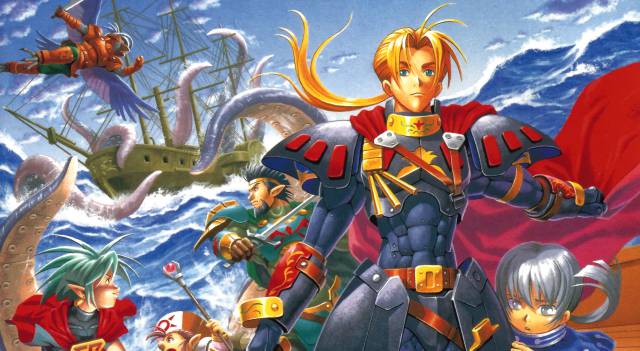 Shining force III
Shining force III
Considered one of the best Strategy-RPG in history, SF beats Final Fantasy Tactics and Vandal Hearts in charisma. Its three chapters are a success, this time, marketing, its history is incredible and its playability most fervent. The pity is that SEGA of America and SEGA Europe did not trust this CD, and published a very limited number of the first chapter. It is an expensive game to obtain today in English, either NTSC or PAL, so its price can reach 60-100 euros depending on whether it is the USA or European version. Of course, the second and third chapters stayed in Japan. Interestingly, it is more complicated to find Scenario 2, and in addition, for the owners of the Sega trilogy published the "Premium Disc", only obtainable after gathering the three coupons that accompanied the two copies. There is a complete translation of the game on the Internet for those who want to enjoy it.
Nights became the great hope of the SEGA console. Without any title with Sonic as the protagonist on the horizon, the Sonic Team was immersed in other projects. The first of these was this "Nights into dreams", a game with pseudo-3D development that caused shock due to the graphic beauty it showed on the screen, and for being very different from everything seen before. With him some mouths were silenced regarding the possibilities of the console, SEGA also took the opportunity to launch it (August 1996 in the USA) together with a 3D pad in the style of Nintendo 64, and today is a myth among the SEGA community, to the expect someone to dare to do a second part someday.
The other great Sonic Team star title was Burning Rangers, a curious arcade starring futuristic firefighters where the gameplay was mixed with technical displays of Saturn hardware. It is a compact wanted because few copies were published, appeared when the console was about to die in Europe and America, and also the Japanese version includes an extra soundtrack quite appealing.
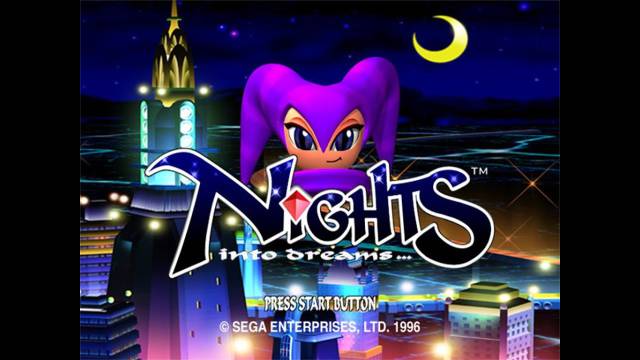 Nights, Sega's great hope to compete against Mario
Nights, Sega's great hope to compete against Mario
Although it seems illogical, the Sonic titles (which did appear) were commissioned to an external company (as Nintendo usually does with one of its licenses). Specifically Traveler's Tales was responsible for the Saturn conversion of "Sonic 3D Flikis' Island", a game originally created for Mega Drive and that caused some disappointment among Sonic fans. In addition, Traveler's Tales created a second product, Sonic R, with a soundtrack produced by SEGA and whose quality was quite high. Both titles were much discussed by the press, and implied that SEGA intended to get rid of his pet (the first sign was Knucles Chaotix for 32X).
After Street Fighter 2 and substitutes, everyone thought that the next chapter would be SF 3, but Capcom surprised everyone with a new series, Street Fighter Alpha, featuring rejuvenated and successful "Special Moves" characters, improving those appearing in Super Street Fighter and that would eventually prevail in all the sagas of both Capcom and SNK. The popularity of these games made it also appear a very interesting animated film about SFA, whose success continued with the series broadcast here on some regional circuits
"Street Fighter Alpha" appeared surprisingly for SNES, Saturn and PlayStation. The second part was only for 32 bits, and the third for 32 and Dreamcast, in addition to a review for Game Boy Advance. The Saturn version of the latter is at least as good as its younger sister in time, thanks to the extensive use of the 4 MB cartridge. Capcom was one of the few companies that trusted Saturn until the end, although inexplicably his greatest success on PlayStation, Resident Evil, took a long time to be ported to the SEGA console. It goes without saying that second and third parts were never even projected as futuristic, nor were other "survival horror" like "Dino Crisis". Actually, Capcom did consider Sega Saturn during the development of his second part; It is public that in the middle of the process Shinji Mikami stopped the work and rewrote the entire script of "Resident Evil 2", which meant re-programming the Playstation version from scratch, with the consequent delay of dates. During that time, Saturn's plummet made Mikami himself dismiss a possible adaptation.
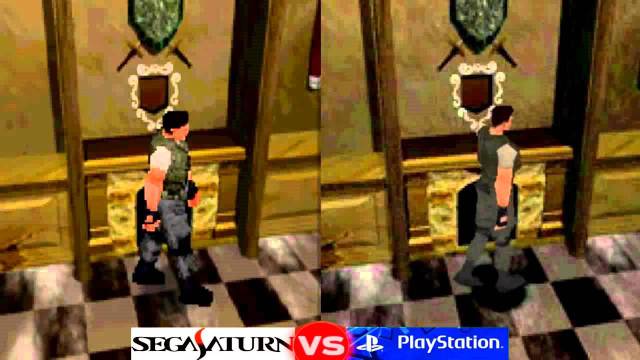
On the other hand, the Megaman phenomenon was experienced, which returned to a SEGA console after many exclusive appearances in SNES. It should be noted that Megaman had been an almost exclusive character of Nintendo, and when a cartridge for Mega Drive was finally confirmed, a stir broke out. As often happens on these occasions, such a stir ended in disappointment, since the port was a compilation of NES games, and not a new chapter of the Megaman X series, as everyone expected. On the other hand, in the 32-bit era, the saga continued until X5 with spectacular results. However, Capcom again distrusted Saturn's possibilities by not transferring her the fantastic "Megaman Legends", one of the best games of this character ever created, which even had a second part
The other big bet of Capcom during those years was the barrage of "cross-over" titles of his most charismatic characters and those of the Marvel. The thing began with a great game entitled "X-Men: Children of the Atom". The success in recreational and the almost perfect conversion to Saturn gave rise to "Marvel Super Heroes", and then began the cross dance between Street Fighter Alpha and Patrol X fighters, unleashing in the glorious "Marvel vs. Capcom", the dream of many of the fans of the fight in two dimensions. The Saturn versions were always superior, thanks to the invention of the memory cartridge, first of 1MB and then expanded to 4MB. Having a recreational at home, at least in 2D, was for the first time true, although none of the most spectacular titles were officially published in the West, because of SEGA's refusal to bring its peripheral, something totally absurd if we consider it from the present
The last two games for this console published by Capcom, were "Dungeon & Dragons Collection". Cult game that includes two parts of this well-known saga of arcades, requires (at least one) the use of a 4MB cartridge, and at the time revived the Saturn myth with this great collection; Its price currently ranges between 100 and 150 euros, it is really difficult to obtain because there are not many copies.
Second, Capcom published Final Fight Revenge, a clearly disappointing title that is also sought because it is considered the last title edited by any company in the 32 bits of SEGA. It also used the 4MB cartridge and converted a game developed for ST-V, the Saturn-compatible board. The disappointment was to know that the last title published for this console (March 2000) had only acceptable graphics despite requiring memory expansion, lacked extras and the music was almost mediocre, all arguing a sad and careless end for a magnificent console
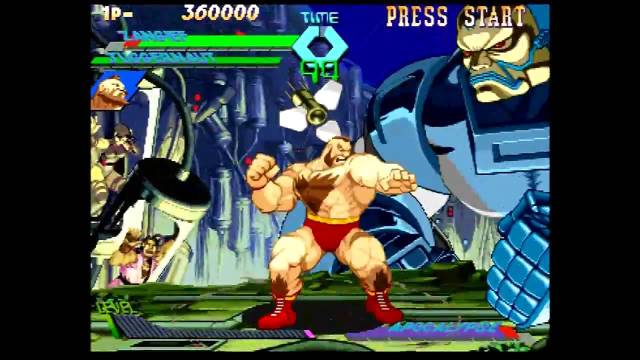 Saturn became the best machine for 2D fighting games of its era
Saturn became the best machine for 2D fighting games of its era
Sony gave a blow of effect when it announced that it acquired a part of Psygnosis. At that time he was known primarily for the series "Lemmings" and "Shadow of the Beast", and his PlayStation projects were creating a lot of expectation. If Namco was the company that secured Sony sales in Japan and the USA, Psygnosis was going to be in Europe. His success was devastating with "Wipeout" and "Destruction Derby", and to a lesser extent with "Krazy Ivan" and "Lemmings 3D", catapulted this console to the number one sales
They began a series of speculations about whether the conversions of these promised titles for Saturn were going to be canceled, and although they eventually came out, the quality decline in some cases was more than evident. To highlight however the careful version of "Wipeout XL", which surprised everyone by being very close to the original, except for some transparencies, light effects, and of course the soundtrack, which due to licensing problems with Sony Music, container of High quality electronic music, such as Orbital, Apollo 440, The Prodigy and other groups, was replaced in the version for the SEGA console.
In those years Electronic Arts pointed ways. He was not the huge giant that he is today, but he already outlined his great market vision, and in addition to developing his mythical sports line, he began to acquire studies such as Bullfrog, and to reap great successes such as Little Big Adventure or Syndicate. In the Mega Drive era, EA was a great ally. Their titles were almost always better on this console than in their equivalents for Super Nintendo. When leaving Trip Hawkins the company, part of the "alliance" was lost, and gradually also the sports line of EA Canada, which was giving such good results. With all this, EA still released a couple of sports titles with more grief than glory, and finally abandoned any relationship with SEGA to this day
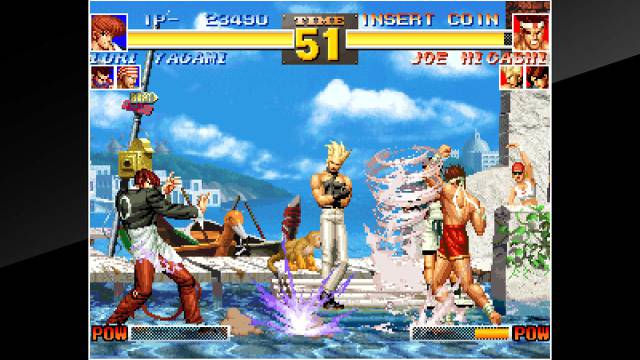 SNK also opted for Saturn after the failure of Neo Geo CD
SNK also opted for Saturn after the failure of Neo Geo CD
SNK was the other great stronghold of SEGA in Japan. With NeoGeo CD disappeared in combat in that country, the 1MB cartridge devised by SNK itself (the twin system designed for The King of Fighters 95) and then the official memory extensions marketed by SEGA, allowed that company to carry out the Better domestic conversions of your recreational. In some cases, the Playstation version offered better extras, such as fan image galleries or alternative game modes, but always the Saturn game looked much better, almost "perfect pixel" and with hardly any reduction of "animation frames."
The saga par excellence of SNK is The King of Fighters; in Saturn the 95, 96 and 97 championships appeared. The visual spectacle is delicious, the fight lovers should not miss these editions, since in addition the Saturn pad is the best to date for this type of games. However, possibly the most compensated saga is Fatal Fury, which had the third part (magnificent conversion, without the use of any extra memory) and also appeared two "extensions" (Real Bout and Real Bout Special). Fatal Fury 3's precious funds, the gameplay (with the inclusion at last of air blockages, combos meter and two types of special blows), and Geese Howard's nth death make it surely the best work of SNK
Technically, the 2D genre was being taken to the maximum, the struggle between SNK and Capcom in the arcades had a meeting point in the domestic versions. However, these titles never came to sell as "Tekken 3" or "Virtua Fighter 2". The genre began to plummet at that moment.
 Soukyugurentai is one of the jewels that sustains the Saturn legend among shoot'em up lovers
Soukyugurentai is one of the jewels that sustains the Saturn legend among shoot'em up lovers
Another reason why owning a brand new Sega Saturn is due to the quantity, and quality, of the shoot'em ups published for it. It is true that most stayed in Japan, as is usual in this type of games, but with some effort you can find real wonders that leave the pavilion of the Matamarians too high for the rest of consoles (perhaps only PC-Engine / Turbo Duo from NEC can approach Saturn in this regard).
Direct conversions of the most famous arcade of authentic legends in the genre such as Psikyo, Atlus, Raizing or Taito had their place in the Saturn catalog. Sólo hay que probar los increíbles Do Don Pachi, Battle Garega, Kingdom Racing, Metal Black, Sengoku Blade, Gekirindan o Strikers 1945 para sentirse realmente a los mandos de cualquiera de las recreativas. Konami también ayudó lo suyo con las recopilaciones del delirante Parodious Deluxe Pack, o los intemporales Gradius, Salamander,… Technosoft, creadores de la obra maestra en Megadrive Thunderforce IV también dieron el callo con la excelente versión de Thunderforce V, los imprescindibles Thunder Force Pack 1 y 2, o los más pasables Batsuwin e Hyper Duel, hermanos menores de lo que podría esperarse de alguien como Technosoft
Dejamos para el final los que a nuestro juicio son los mejores shooters en Saturn: Soukyugerentai, también conocido como Terra Diver, una pequeña obra de arte bastante desconocida de los intemporales Raizing / Eighting y distribuido en el país oriental por EA
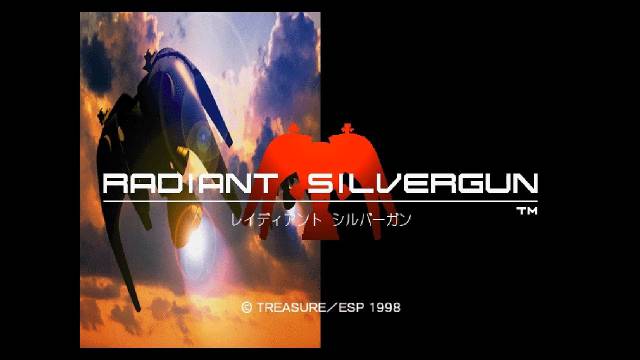 Radiant Silvergun se mantiene como una de las joyas de la corona de Saturn, se han pagado precios altos en la segunda mano por hacerse con una copia.
Radiant Silvergun se mantiene como una de las joyas de la corona de Saturn, se han pagado precios altos en la segunda mano por hacerse con una copia.
Con una creciente dificultad (sobre todo a partir del cuarto nivel), unos gráficos realmente buenos y acción imparable merece la pena que trates de hacerte con él (no es sencillo ni suele ser barato).
Y finalmente el grandioso e intocable (permitidnos la licencia) Radiant Silvergun. El shooter más redondo jamás creado para sistema alguno comandado por los increíbles Treasure (que también nos trajeron el genial Silhouette Mirage, mezcla de acción y disparos).
Gráficos directos de la versión arcade para la placa ST-V que no creerás que son de Saturn, con fondos en alta resolución, transparencias y una suavidad increíble sólo salpicada por contadísimas ralentizaciones, son la mejor carta de presentación ante los ojos. Verlo para creerlo. Pero es que además el juego atesora una de esas jugabilidades intemporales, una historia divertida, una intro anime de las buenas y una dificultad sólo apta para los más curtidos. Simplemente excelente y uno de los discos más codiciados por coleccionista alguno, sobre todo si eres un fanático del género.
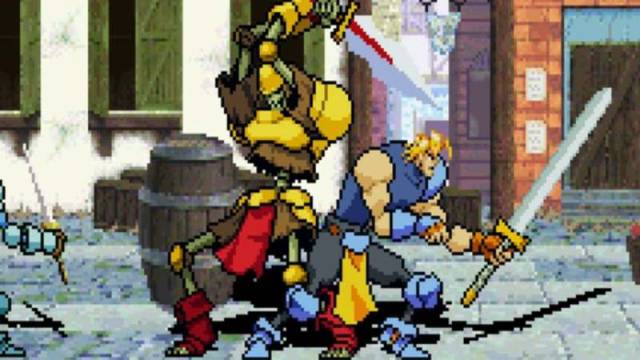 Guardian Heroes, otra de las joyas que Treasure dejó en el sistema
Guardian Heroes, otra de las joyas que Treasure dejó en el sistema
Saturn manejó la alta resolución de una forma magistral tal y como lo pueden confirmar ciertos títulos de la época. Algunas conversiones de Model 2 (Virtua Fighter 2, Virtua Fighter Kids, Virtua Cop 2, Last Bronx); de la placa Titan (Decathlete); o productos independientes (Fighters Megamix) fueron hechas en una resolución mayor a la habitual. La mayoría de estas conversiones son grandes ejemplos del buen catálogo Saturn, aunque también hay deshonrosas excepciones (Sega Touring Car, Manx TT) que levantaron gran expectación y terminaron siendo juegos sin carisma.
Algunos de los mejores representantes de productos "third party" que dejaron gran sabor de boca y que no pueden caer en el olvido son: Guardian Heroes (Treasure es uno de los mejores grupos de programación de la corta historia de los videojuegos), Deep Fear, Magic Knight Rayearth, Dark Saviour, Story of Thor 2 o Saturn Bomberman (el más divertido de la saga hasta la fecha). Todos ellos pueden ser encontrados a un buen precio (entre 15 y 40 euros) en su versión inglesa. También destacar las enésimas conversiones de Bandai de Dragon Ball; en esta ocasión lanzó dos títulos para PSOne y Saturn, el primero común ("The Legend") y el segundo en 2D para Saturn (Shin Butouden) y pseudo-3D para PSOne (Ultimate battle 22), siendo el Shin Butouden uno de los mejores juegos basados en el famoso anime junto con a Dragon Ball Z2 de SNES.
Dentro de la producción "in house", destacar también las dos partes de un RPG de culto, Dragon Force, reeditado para PS2 bajo el sello SEGA Ages, y que se acerca mucho a la idea de Heroes of Might and Magic para PC, pero con una mecánica más sencilla y unos combates espectaculares. Existen todavía muchos títulos de mediana o alta calidad, es muy posible que todos no pudiesen tener cabida en este artículo.
Saturn apenas sobrevivió a 1998. En ese año SEGA oficialmente abandonó este sistema, al tiempo que comenzaban a oírse rumores de un nuevo hardware (por aquel entonces conocido como Sega Katana, Dural y Black Belt). Después de haber liderado el mercado japonés desde su salida hasta bien entrado el 97 comenzaron los síntomas de cansancio incluso en su país natal, y mientras su presencia en Europa fue casi anecdótica, en Estados Unidos aún se publicaron 3 títulos de SEGA y un cuarto titulado "Magic Knight Rayearth", cuya traducción había sido largamente esperada, y cuyo periplo hasta ser publicado es un fiel reflejo de la política de SEGA con su Saturn.
Fue una muerte agónica en los territorios occidentales para una consola que no mereció tal suerte, y que debió su amargo cabalgar a los múltiples errores y la prepotencia del número uno de Sega Japón. Aun así, Sega Saturn continuó viva en ese país gracias a la reedición de clásicos, a su línea barata, al mercado de segunda mano (muy prolífico allá) y fundamentalmente a los juegos "picantes" o "hentai", un verdadero filón que despuntó en gran medida por la alta permisividad de SEGA con estos títulos, mucho más explícitos que la mayoría de los también existentes para Playstation.
Como ya se ha dicho, SEGA desequilibró el peso de una mascota en sus 32 bits, hasta el punto que relegó a un segundo plano el desarrollo de juegos basados en Sonic, auténtico valedor de la época de 16 bits. Sin embargo, en secreto sí existió un proyecto inicial para hacer un Sonic en tres dimensiones enteramente, proyecto que fue encargado al instituto de tecnología (Sega Technical Institute) que la propia SEGA tenía en Estados Unidos.
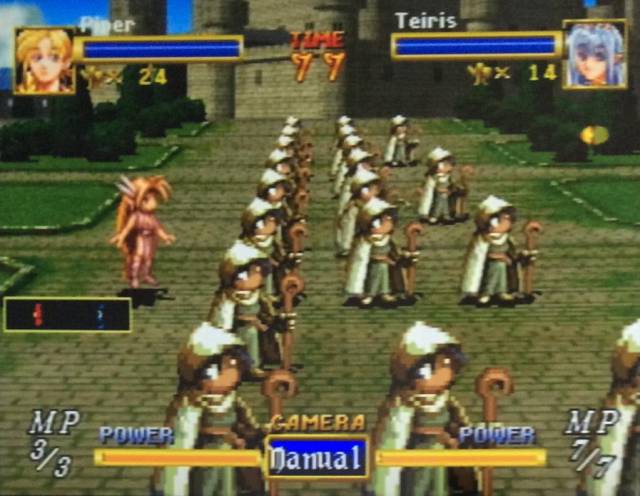 Dragon Force y sus espectaculares batallas fue uno de los juegos por los que no se apostó en occidente
Dragon Force y sus espectaculares batallas fue uno de los juegos por los que no se apostó en occidente
El equipo de desarrollo se mantuvo durante casi dos años, y recibió el apoyo de una parte del Sonic Team, incluido Naka San, autor de los primeros juegos de la saga y cuyo trabajo en Japón no le satisfacía lo suficiente. Sin embargo, la situación financiera de la compañía, el debut de Mario 64 y los titubeos del mercado americano hicieron finalmente desestimar un trabajo que nunca vio la luz y que fue enteramente reescrito para la sucesora de Saturn, la Dreamcast, que apareció con el nombre de "Sonic Adventure" y que obtuvo críticas dispares pero un éxito de ventas apabullante.
Para jugadores que estén pensando en importar juegos NTSC existe una herramienta indispensable: el Action Replay. A pesar de ser un producto descatalogado, en multitud de tiendas online se puede encontrar por apenas 24 euros para la versión 4 en 1. Se trata de un cartucho a introducir en la ranura preparada para ello que intercepta el arranque de la consola y permite jugar con discos japoneses y americanos. Actúa además como una tarjeta de memoria de 8MB de capacidad, aunque los juegos no la reconocen y es necesario grabar primero en la memoria interna y luego pasar los datos al cartucho. Y finalmente su compatibilidad con todos los juegos que requieran la ampliación de memoria de 1 o 4 MB (de Capcom y SNK fundamentalmente).

Otros periféricos interesantes son la pistola (para la saga Virtua Cop o House of the Dead), el pad 3D de Nights, el Arcade Stick (de mejor calidad incluso que el de Dreamcast), el pad de Ascii reeditado después para Dreamcast y PS2 (si lo encuentras), la tarjeta descompresora MPEG y Video CD (como curiosidad principalmente, aunque hubo algún juego en Japón que sí llegó a utilizar esta funcionalidad, como es el caso de "Silver Star Story MPEG Card Versión" basado en los populares Lunar), y el volante oficial de SEGA. En algunos lugares se puede encontrar el cartucho con el software necesario para conectarla a Internet, pero esto es realmente difícil, caro y prácticamente inservible en la actualidad
Bibliografía
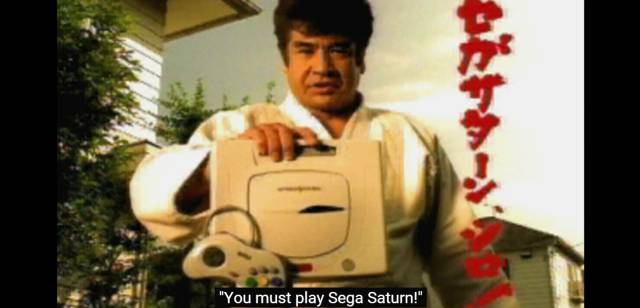
La base de todo este artículo bebe de diferentes fuentes. Por un lado, la experiencia personal propia, desde la salida en Japón de las dos máquinas de SEGA y Sony (24 de noviembre y 3 de diciembre de 1994 respectivamente) hasta el anuncio oficial del cese de toda actividad en los USA y Europa relacionada con Saturn el 31 de marzo de 1998. En segundo lugar, las largas entrevistas concedidas por Otawa (segundo de a bordo en Sega of Japan y en la sombra de sus CEO durante todos estos años), Kalinske, Irimajiri (CEO de Sega of America tras la renuncia de Kalinske y David Rosen, y luego CEO de la matriz en Japón durante el desembarco de Dreamcast), Stolar (odiado por muchos al suceder en el cargo a Kalinske y comenzar a tomar decisiones drásticas en 1997). En tercer lugar, la publicación de artículos de revistas especializadas sobre los diferentes CES y E3 de la época, la batalla entre Sony y SEGA desde 1994 hasta 1997, las notas de prensa distribuidas por SEGA en esa época, y un acopio de cifras de ventas que cronológicamente van moviendo a SEGA desde la primera posición hasta el debacle final.
Conclusiones
Contrariamente a lo que se piensa Saturn no fue un mal hardware, en absoluto. Nunca llegó a mostrar su potencial real, pero fue una consola maldita desde su nacimiento. Las locuras de un CEO como Hayao Nakayama, analizadas años después, concluyen incluso que Saturn fue una máquina desestimada en gran medida por sus propios dirigentes. Un cúmulo de despropósitos que llevó a la compañía al borde de la quiebra, con multitud de deudas y sin apenas prestigio, merecería un análisis aparte a la situación de la consola durante su ciclo de vida. Por suerte, durante ese tiempo algunos equipos crearon juegos que pueden pasar a los anales de la historia como verdaderas obras de arte, y es lo que separa a esta consola de caer en el olvido, como sí hicieron máquinas contemporáneas suyas.
El mercado es así, habitualmente gana el que tiene mejor producto y también sabe promocionarlo rápida y efectivamente. Sony vino para demoler a las "vacas sagradas" y la antigua creencia de que la industria la movían las grandes marcas del videojuego. Las reacciones como esta de Sega llegaron en un momento de descrédito, y nunca se podrá decir que la victoria de Sony sobre las demás fue inmerecida, pero en beneficio de todos debería haber habido más competencia. La victoria fue quizá prematura.

